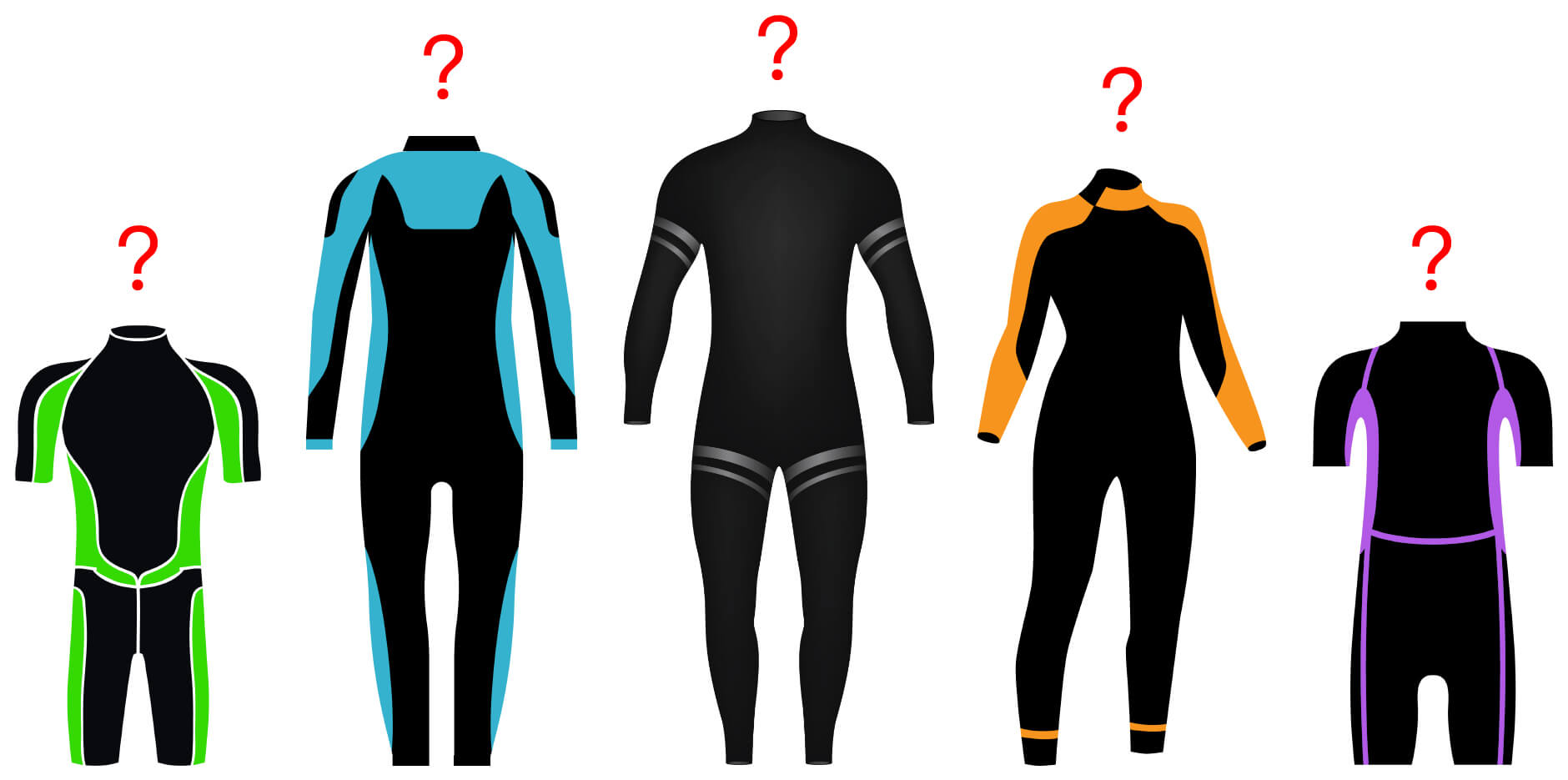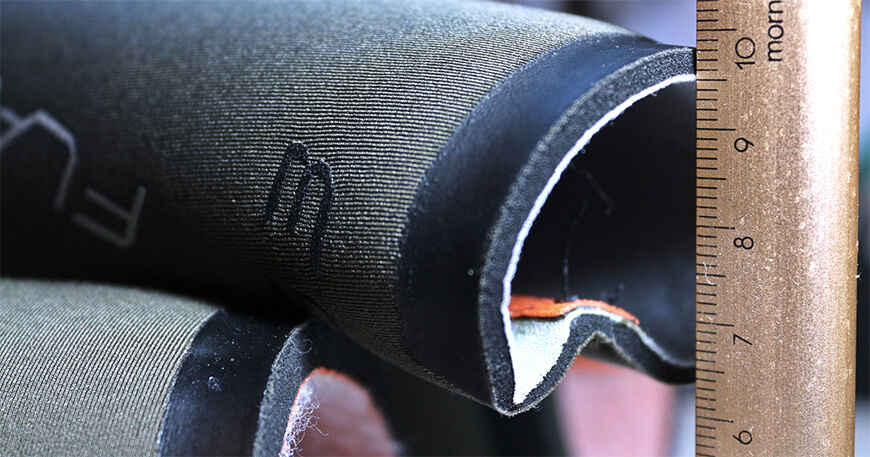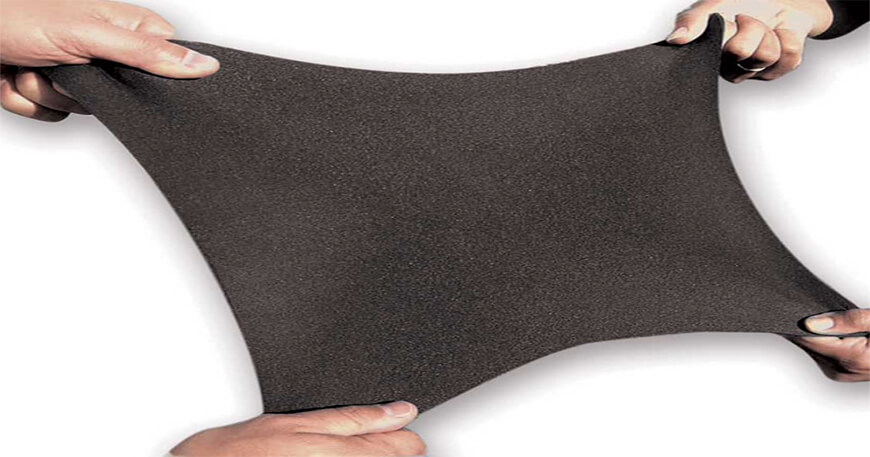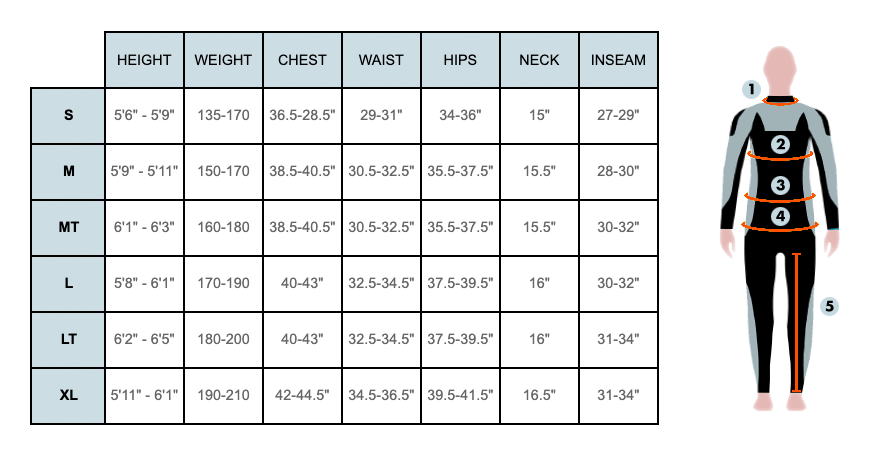
When choosing a wetsuit, there are usually four main factors to consider:
1. Warmth
2. Flexibility
3. Durability
4. Sizing & Fit
Each of these four components affects the others. For example, when you choose a wetsuit with neoprene reinforcement tape on the inside seams, it will provide extra durability and comfort at the expense of flexibility. Other factors need to be considered when choosing a wetsuit, such as entry system (zipper style), wetsuit weight, price, etc.
Below we go into detail about each of the four main considerations:

Obviously, the main purpose of a wetsuit is to keep you warm. Other than keeping you warm for comfortability reasons, warmth will also allow you to have longer sessions during the cold season. Have you ever been surfing on a cold day when the waves are pumping, then within an hour after getting in the water you start shivering and have to get out? Having the right amount of warmth will keep you in the water longer.
In general, water temperature will be the deciding factor in selecting the warmth level of a particular wetsuit. However, the air temperature and wind chill factor are equally important. The longer your body is above water, the more significant the wind chill factor is. During the coldest months in Taiwan, the water temperature is almost always higher than the air temperature. Since Taiwan is located in the Tropics/Subtropics, direct overhead sunlight keeps surface waters consistently warm throughout the year.
Following shows the warmest sea temperatures (July) and coldest sea temperatures (January) in Taiwan:
North: 84°F/64°F
Northeast: 84°F/68°F
East: 86°F/72°F
South: 86°F/73°F
Southwest: 86°F/72°F
Northwest: 81°F/63°F
For current and forecasted sea temperatures, check out our surf forecasts and surf reports here.
The following factors will all affect a wetsuit’s level of warmth:
Thickness
The factor that affects a wetsuit’s warmth the most is the thickness of the neoprene, the thicker the warmer.
During winter, a good wetsuit choice for the north would be one with a 3/2 mm thickness. For the south, a 3/2 mm or 2 mm wetsuit. During spring and autumn, all of Taiwan could get away with a 1 mm or 2mm. No need for a wetsuit during summer in Taiwan…unless you’re looking to sweat off a few pounds per session!
Internal Lining
Many wetsuits have internal linings made from synthetic fleece-like materials. These linings provide additional insulation and more comfort to the wetsuit, and typically dry faster than regular nylon-lined neoprene wetsuits. A quick-drying wetsuit will allow you to enjoy multiple sessions in one day without having to put on a wet and cold wetsuit. The downside of internal linings is that they add weight and reduce flexibility.
If you want a wetsuit with more warmth and comfort, go with internal linings. If you want a wetsuit with more flexibility, get one without linings.
Entry System
The point of entry into a wetsuit (how you get into it) is known as the “entry system.” It is very important for the overall function of the wetsuit. There have been many different kinds of entry systems over the years, but the following three are currently the most popular:
Putting On & Taking Off
(Easy) Back >> Chest >> Zipperless (Difficult)
Flexibility
(Good) Zipperless >> Chest >> Back (Normal)
Price
(Most Expensive) Zipperless >> Chest >> Back (Least Expensive)
Seam Construction
Explained in the
"Durability" section below.
Type of Neoprene
1. Nylon-Lined Neoprene (most flexible)
2. Smooth Skin Neoprene (increases warmth, but less durable)
3. Air Neoprene (increases warmth, but expensive)
4. Yulex (plant-based neoprene alternative developed by Patagonia, which creates a much smaller carbon footprint and is more environmentally-friendly than neoprene)

Flexibility in a wetsuit represents the ability of the neoprene to stretch, increasing movement performance and making it easier to put on and take off (without making you fall over while cursing the wetsuit!). A wetsuit made from “stretchy” neoprene will be more flexible, more comfortable, fit better, and allow you to use less energy while surfing.
The main factor affecting a wetsuit’s flexibility is the thickness of the neoprene it’s made from. Comparing different neoprene thicknesses (assuming they are all the same quality of neoprene), the thicker the neoprene the poorer the flexibility will be. A 4mm wetsuit will have less flexibility than a 3mm wetsuit. It will also be heavier, have less movement performance, and be more difficult to take off.
In the modern wetsuit age, most wetsuit companies have developed their own branded neoprene, which is much more elastic than the "old" neoprene. Each company will have its own neoprene name, but they are all essentially the same. The important things to focus on are the weight of the neoprene (the lighter the better) and the stretch of the neoprene (“super stretch” wetsuit fabrics will increase by at least 100% when stretched, whereas a less expensive neoprene will stretch by only 50%).
Ensuring that your wetsuit will last is key, especially since a good wetsuit is relatively expensive. In general, the seams of a wetsuit are its weakest point, so the best way to determine the durability of a wetsuit is by the seam construction. Seams are the thread connection of two or more wetsuit panels, which are usually also glued together to create a waterproof seal.
In an effort to manufacture the most watertight, flexible, and durable seam, wetsuit companies employ a variety of methods to seal and reinforce their seams. Following are the most widely used stitching and sealing methods:
Flatlock Seams
The flatlock seam is the most basic and least expensive seam. It is typically used on wetsuits that are 3 mm and under, as well as spring suits that are 2 mm and under. Flatlock wetsuits are also glued in order to make the seam as watertight as possible. However, due to the nature of the stitch, which penetrates all the way through the neoprene creating tiny holes, the flatlock seam is the least watertight and least durable.
When considering the coldest sea temperatures in northern Taiwan (63°F - 68°F) in January, a flatlock wetsuit is not recommended. For southern Taiwan in January (72°F - 73°F), a flatlock wetsuit is more than adequate.
Flatlock Seams
The flatlock seam is the most basic and least expensive seam. It is typically used on wetsuits that are 3 mm and under, as well as spring suits that are 2 mm and under. Flatlock wetsuits are also glued in order to make the seam as watertight as possible. However, due to the nature of the stitch, which penetrates all the way through the neoprene creating tiny holes, the flatlock seam is the least watertight and least durable.
When considering the coldest sea temperatures in northern Taiwan (63°F - 68°F) in January, a flatlock wetsuit is not recommended. For southern Taiwan in January (72°F - 73°F), a flatlock wetsuit is more than adequate.
GBS (Glued and Blind Stitched) Seams
Blind stitched wetsuits are the most ideal for cold water surfing. The blind stitched method does not completely penetrate the neoprene, allowing for a completely watertight, durable, and flexible seam. As a result, blind stitched wetsuits are typically more expensive, but definitely worth it if you surf in cold water and/or want to extend your time in the water. If you’re looking for a wetsuit with the best seal, flexibility, and price, a GBS wetsuit is the way to go.
GBS (Glued and Blind Stitched) Seams
Blind stitched wetsuits are the most ideal for cold water surfing. The blind stitched method does not completely penetrate the neoprene, allowing for a completely watertight, durable, and flexible seam. As a result, blind stitched wetsuits are typically more expensive, but definitely worth it if you surf in cold water and/or want to extend your time in the water. If you’re looking for a wetsuit with the best seal, flexibility, and price, a GBS wetsuit is the way to go.
Liquid Sealed Seams
Liquid sealed seams are found on high-end wetsuits and apply a liquid rubber on top of the stitched seam (typically a GBS seam). This gives the wetsuit an additional layer of protection from water entering, and is more durable than GBS. Some wetsuits will have liquid seams on the outside and on the inside, making them 100% watertight. One downside of liquid seals is that they will crack, split, and peel over time (after 100 - 150 sessions, depending on the brand).
Liquid Sealed Seams
Liquid sealed seams are found on high-end wetsuits and apply a liquid rubber on top of the stitched seam (typically a GBS seam). This gives the wetsuit an additional layer of protection from water entering, and is more durable than GBS. Some wetsuits will have liquid seams on the outside and on the inside, making them 100% watertight. One downside of liquid seals is that they will crack, split, and peel over time (after 100 - 150 sessions, depending on the brand).
Taped Seams
A taped seam uses a flexible tape that is applied on the inside of a wetsuit. It produces a watertight seal, additional durability, and reduced seam irritation on the skin. There are different kinds of tapes used, but neoprene tape is the best as it produces the greatest amount of flexibility. Neoprene tape can be applied with normal glue or it can be heat-welded onto the fabric, further reducing skin irritation.
Taped Seams
A taped seam uses a flexible tape that is applied on the inside of a wetsuit. It produces a watertight seal, additional durability, and reduced seam irritation on the skin. There are different kinds of tapes used, but neoprene tape is the best as it produces the greatest amount of flexibility. Neoprene tape can be applied with normal glue or it can be heat-welded onto the fabric, further reducing skin irritation.

It’s of utmost importance that you select a wetsuit with the correct fit for your body type. Wetsuit sizing varies for each brand, so referencing the brand’s sizing chart is the first place to start.
A wetsuit should fit tightly, but not so tight that your range of motion is limited. The two most important factors to consider are height and weight, and then chest measurement. The sleeves of a full-length wetsuit should fall near the wrist bone. The legs should fall just above the ankle bone.
After a wetsuit gets wet, it will loosen up and feel more comfortable, and after a few sessions you should notice that it fits to your body better. If your wetsuit is too tight, you will be warm in the water but your movement will be restricted and your surfing will suffer. A tight wetsuit will also break down more quickly. If your wetsuit is too loose, it will be easier to put on and take off, but you will get cold much more quickly and as a result need to get out of the water sooner.
Never purchase a wetsuit based on your normal clothing size. It’s also best to speak to a salesperson who knows wetsuits in and out, preferably someone who works at a wetsuit company.
We hope this article will help you choose the perfect wetsuit, and that it will allow you to stay in the surf for longer and more enjoyable cold-water sessions. See you there!
Check out our other surf articles: